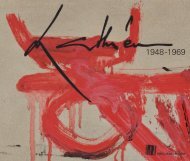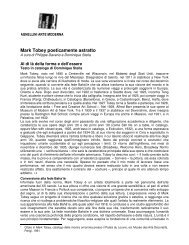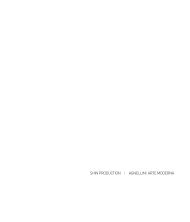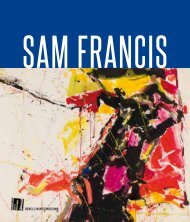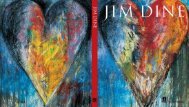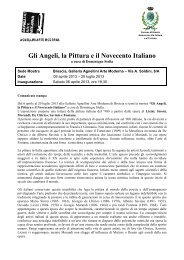Shin production | Agnellini Arte ModernA - Galleria Agnellini Arte ...
Shin production | Agnellini Arte ModernA - Galleria Agnellini Arte ...
Shin production | Agnellini Arte ModernA - Galleria Agnellini Arte ...
Create successful ePaper yourself
Turn your PDF publications into a flip-book with our unique Google optimized e-Paper software.
da diverso tempo, ma non nei rapporti umani, né verso<br />
l’uomo né verso la comprensione delle arti di ciascuno quali<br />
componenti di tale sfericità. come sempre, ci siamo occupati<br />
eccessivamente di ciò che è esterno, obiettivo, a scapito del<br />
mondo interno ove risiede la vera sfericità […].<br />
il nostro tempo è universale e la rilevanza di tale tempo<br />
punta alla necessità di universalizzare la consapevolezza<br />
e la coscienza umana. il nostro futuro dipende dalla<br />
consapevolezza di ciò. [...] l’America, più di ogni altro<br />
paese, ha una posizione geografica tale da promuovere<br />
tale comprensione. esaminando come si è comportata<br />
in passato, questa ha sempre guardato all’europa; oggi,<br />
invece, deve assumere una propria posizione e, come giano<br />
bifronte, guardare anche verso l’Asia, poiché a breve le onde<br />
dell’oriente solcheranno abbondantemente le nostre coste.<br />
tutto ciò è profondamente connesso al suo sviluppo nell’arte,<br />
specialmente sui versanti pacifici. di ciò sono consapevole.<br />
naturalmente, il mio lavoro rifletterà tale condizione, e non mi<br />
sorprende che un orientale reagisca nei confronti di un mio<br />
dipinto proprio come un americano o un europeo. (1946)<br />
consciousness and the conscience of man. it is in the<br />
awareness of this that our future depends. [...] America<br />
more than any other country is placed geographically to<br />
lead in this understanding, and if from past methods of<br />
behaviour she has constantly looked toward europe, today<br />
she must assume her position, Janus-faced, toward Asia,<br />
for in not too long a time the waves of the orient shall<br />
wash heavily upon her shores.<br />
All this is deeply related with her growth in the arts,<br />
particularly upon the pacific slopes. of this i am aware.<br />
naturally my work will reflect such a condition and so it<br />
is not surprising to me when an oriental responds to a<br />
painting of mine as well as an American or a european.<br />
(1946)<br />
i have no system – i never know when i can paint; i just<br />
have to arouse myself – get into a state and forget all<br />
things if possible to make a union with what i am doing<br />
and the less i think of it – the paintings and myself, the<br />
better the result. there is a famous Zen or tao verse – in<br />
non ho un mio sistema – non so mai quando posso<br />
dipingere; devo semplicemente scuotermi – trovarmi in<br />
una data condizione e dimenticare tutto, se possibile,<br />
per creare una simbiosi con ciò che sto facendo, e meno<br />
ci penso – alle pitture e a me stesso - meglio è. c’è un<br />
famoso verso Zen o tao – che tradotto diventa:<br />
dietro la tecnica, sappiate che c’è lo spirito (ri)<br />
Sta albeggiando ora;<br />
aprite lo schermo,<br />
ed ecco, la luce della luna<br />
sta brillando all’interno.<br />
penso che questa poesia, lo Zen e l’arte del tiro con<br />
l’arco siano tutto ciò che occorre sapere per dipingere<br />
– dipingere e dipingere, esprimersi e poi giudicare, se<br />
possibile. la poesia è tratta da Zen and Japanese culture<br />
di Suzuki.<br />
oggigiorno, alcuni artisti parlano dell’atto del dipingere<br />
ma, in realtà, uno Stato Mentale è il primo passo da cui<br />
procede l’azione. la pace Mentale è un altro ideale, forse<br />
translation thus:<br />
behind the technique, know that there is the spirit (ri)<br />
it is dawning now;<br />
open the screen,<br />
and lo, the moonlight is<br />
shining in.<br />
i think this poem and Zen and the art of archery is all one<br />
needs to know and go ahead and paint – and paint and<br />
paint and let out and then judge – if possible. this poem<br />
comes from Suzuki’s Zen and Japanese culture.<br />
We hear some artists speak today of the act of painting,<br />
but a State of Mind is the first preparation and from this<br />
the action proceeds. peace of Mind is another ideal,<br />
perhaps the ideal state to be sought for in the painting and<br />
certainly preparatory to the act.<br />
[...] “writing” the painting [...] became a necessity. i often<br />
thought of my way of working as a performance in that it<br />
had to be achieved all at once or not at all. (c. 1954)<br />
m a r k t o b e y 56<br />
lo stato ideale da ricercare nella pittura, e sicuramente<br />
uno stato preparatorio all’atto.<br />
[...] “scrivere” la pittura [...] divenne una necessità. ho spesso<br />
pensato al mio modo di lavorare come ad uno spettacolo poiché<br />
doveva realizzarsi all’istante o per niente. (ca. 1954)<br />
penso che la pittura debba arrivare attraverso i viali della<br />
meditazione piuttosto che i canali dell’azione. (dagli anni ‘60)<br />
lavorare orientati verso e, al contempo, lontano da quel<br />
momento critico che si verifica in una sorta di trance, ove si<br />
esprimono soluzioni mai sognate prima d’ora dalla mente<br />
cosciente – il momento in cui tutto si fonde.<br />
l’artista non copia più la natura. È interessato a ciò che pensa<br />
di essa.<br />
preferisco vedere nella natura ciò che voglio realizzare nel mio<br />
quadro. Quando troviamo l’astratto in natura, troviamo l’arte più<br />
profonda.<br />
i believe that painting should come through the avenues<br />
of meditation rather than the canals of action. (From the<br />
60’s)<br />
Work towards and away from that critical moment which<br />
takes place in a kind of trance, where solutions happen<br />
undreamed-of by conscious mind – the moment when<br />
everything fuses.<br />
the artist no longer copies nature. he is interested in what<br />
he feels about it.<br />
i like best to see in nature what i want in my painting.<br />
When we can find the abstract in nature we find the<br />
deepest art.<br />
My main problem in painting is, i believe, rhythm and<br />
plasticity, often the sensitivity of touch which one calls a<br />
feeling for texture. because i don’t have any fixed ideas,<br />
i should say, no philosophical affinity which conceived<br />
57 m a r k t o b e y<br />
penso che il problema maggiore nella pittura sia il ritmo e la<br />
plasticità, spesso la sensibilità del tocco che definiamo come un<br />
certo “feeling per la materia”. poiché non ho idee fisse o<br />
nessuna affinità fisica che dia origine a metodi definiti, il mio<br />
lavoro è sempre un flusso costante o, quanto meno, questo è<br />
quello che appare ai miei occhi.<br />
Sempre in movimento – così i filosofi greci consideravano<br />
l’essere essenziale dell’anima – così ho cercato di estrapolare<br />
qualche frammento di quella bellezza che ha dato origine ai<br />
miracoli del cosmo e che risiede nell’aspetto plurisfaccettato<br />
della vita.<br />
Alcuni critici mi hanno accusato di essere ciò che chiamano un<br />
orientalista e di aver adoperato modelli orientali nel mio lavoro.<br />
Ma si sbagliano. perché mentre “battagliavo” in giappone e<br />
cina con l’inchiostro Sumi e col pennello, cercando di<br />
capire la calligrafia dell’estremo oriente, mi resi conto che<br />
non sarei mai stato nient’altro altro che un occidentale.<br />
ciò che ho davvero sviluppato in quell’occasione è stato<br />
methods, my work is obviously in a state of constant flux or<br />
at least that is how it seems to me.<br />
Always in movement – that is how the greek philosophers<br />
saw the essential being of the soul – so, i have tried to tear<br />
out just a few scraps of that beauty which makes up the<br />
miracles of the cosmos and which is in the multi-faceted<br />
ness of life.<br />
Some critics have criticized me for being what they called<br />
an orientalist and for using oriental models for my work.<br />
but they were wrong. because when i was struggling<br />
in Japan and china with Sumi-ink and the brush, trying<br />
to understand the calligraphy of the Far-east, i became<br />
aware that i would never be anything other than the<br />
Westerner that i am. but what did develop there was what<br />
i call the calligraphic impulse that has opened out new<br />
horizons for my work. now i could paint the turmoil and<br />
tumult of the great cities, the intertwining of the lights and<br />
the streams of people caught up in the mesh of their net.



